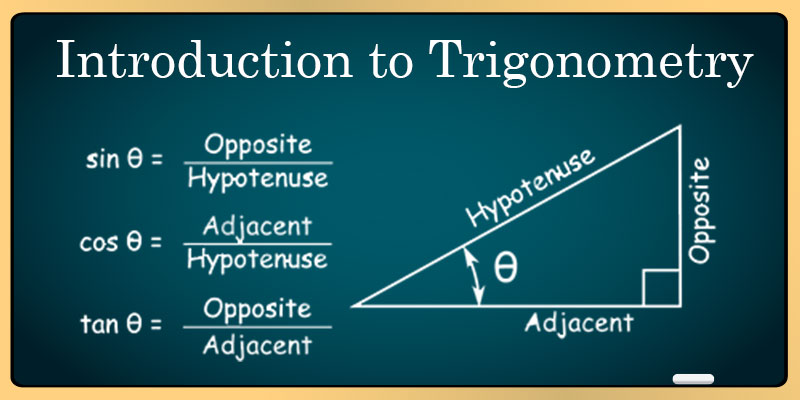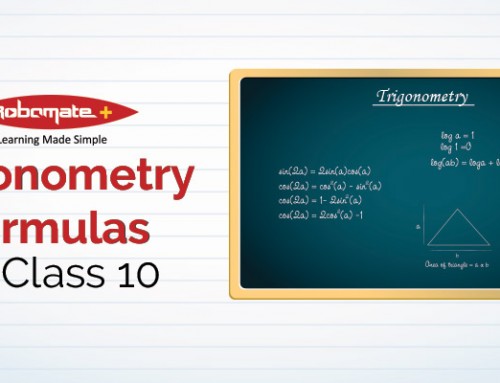Exercise 8.1
Q1) In △ABC , 90∘ at B, AB=24cm, BC = 7cm.
Determine:
(i)sin(A), cos(A)
(ii) sin(C), cos(C)
Ans.) In △ABC , ∠B=90∘
By Applying Pythagoras theorem, we get
AC2=AB2+BC2
(24)2+72 =(576+49)
AC2 = 625cm2
à AC = 25cm
(i) sin(A) = BC/AC = 7/25
Cos(A) = AB/AC = 24/25
(ii) sin(C) = AB/AC =24/25
cos(C) = BC/AC = 7/25
Q2) In the given figure find tan(P) – cot(R)
Ans.) PR = 13cm,PQ = 12cm and QR = 5cm
According to Pythagorean theorem,
132=QR2+122 169=QR2+144 QR2=169−144=25 QR=25−−√=5
tan(P) = oppositesideadjacentside=QRPQ=512
cot(P) = adjacentsideoppositeside = PQQR = 512
tan(P) – cot(R) = 512−512=0
Therefore ,tan(P) – cot(R) = 0
Q3) If sin(A) = 3/4, calculate cos(A) and tan(A)
Ans.) Let △ABC , be a right-angled triangle, right-angled at B.
We know that sin(A) = BC/AC = 3/4
Let BC be 3k and AC will be 4k where k is a positive real number.
By Pythagoras theorem we get,
AC2=AB2+BC2
(4k)2=AB2+(3k)2
16k2−9k2=AB2
AB2=7k2
AB=7–√k
cos(A) = AB/AC = 7–√k/4k=7–√/4
tan(A) = BC/AB =3k/7–√=3/7–√
Q4) In question given below 15cot(A) = 8 ,find sin A and sec A.
Ans.) Let △ABC be a right angled triangle, right-angled at B.
We know that cot(A) = AB/BC = 8/15
Given
Let AB side be 8k and BC side 15k
Where k is positive real number
By Pythagoras theorem we get,
AC2=AB2+BC2
AC2=(8k)2+(15k)2
AC2=64k2+225k2
AC2=289k2
AC = 17k
sin(A) = BC/AC = 15k/17k = 15/7
sec(A) =AC/AB =17k/8k = 17/8
Q5) Given sec Ѳ =13/12, calculate all other trigonometric ratios.
Ans.) Let △ABC be right-angled triangle, right-angled at B.
We know that sec Ѳ =OP/OM =13/12(Given)
Let side OP be 13k and side OM will be 12k where k is positive real number.
By Pythagoras theorem we get,
OP2=OM2+MP2
(13k)2=(12k)2+MP2
169(k)2−144(k)2=MP2
MP2=25k2
MP = 5
Now,
sin Ѳ = MP/OP = 5k/13k =5/13
cos Ѳ = OM/OP = 12k/13k = 12/13
tan Ѳ = MP/OM = 5k/12k = 5/12
cot Ѳ = OM/MP = 12k/5k = 12/5
cosec Ѳ = OP/MP = 13k/5k = 13/5
Q6) If ∠A and ∠B are acute angles such that
cos(A) = cos(B), then show ∠A =∠B .
Ans.) Let △ABC in which CD⊥AB .
A/q,
cos(A) = cos(B)
à AD/AC = BD/BC
à AD/BD = AC/BC
Let AD/BD =AC/BC =k
AD =kBD …. (i)
AC=kBC …. (ii)
By applying Pythagoras theorem in △CAD and △CBD we get,
CD2=AC2−AD2 ….(iv)
From the equations (iii) and (iv) we get,
AC2−AD2=BC2−BD2 AC2−AD2=BC2−BD2 k2(BC2−BD2)=BC2−BD2 k2=1
Putting this value in equation (ii) , we obtain
AC = BC
∠A=∠B (Angles opposite to equal side are equal-isosceles triangle)
Q7) If cot Ѳ = 7/8, evaluate :
(i) (1+sin Ѳ)(1-sin Ѳ) / (1+cos Ѳ)(1-cos Ѳ)
(ii) cot2Θ
Ans.) Let △ABC in which ∠B=90∘
and ∠C=Θ
A/q,
cot Ѳ =BC/AB = 7/8
Let BC = 7k and AB = 8k, where k is a positive real number
According to Pythagoras theorem in △ABC we get.
AC2=AB2+BC2
AC2=(8k)2+(7k)2
AC2=64k2+49k2
AC2=113k2
AC=113−−−√k
sin Ѳ = AB/AC = 8k/113−−−√k=8/113−−−√
and cos Ѳ = BC/AC = 7k/113−−−√k=7/113−−−√
(i) (1+sin Ѳ)(1-sinѲ)/(1+cosѲ)(1-cos Ѳ) = (1−sin2Θ)/(1−cos2Θ)
= 1−(8/113−−−√)2/1−(7/113−−−√)2
= {1-(64/113)}/{1-(49/113)} = {(113-64)/113}/{(113-49)/113} = 49/64
(ii) cot2Θ=(7/8)2=49/64
Q8) If 3cot(A) = 4/3, check whether (1−tan2A)/(1+tan2A)=cos2A−sin2A or not.
Ans.) Let △ABC in which ∠B=90∘
A/q,
cot(A) = AB/BC = 4/3
Let AB = 4k an BC =3k, where k is a positive real number.
AC2=AB2+BC2
AC2=(4k)2+(3k)2
AC2=16k2+9k2
AC2=25k2
AC=5k
tan(A) = BC/AB = 3/4
sin(A) = BC/AC = 3/5
cos(A) = AB/AC = 4/5
L.H.S. = (1−tan2A)(1+tan2A)=1−(3/4)2/1+(3/4)2=(1−9/16)/(1+9/16)=(16−9)/(16+9)=7/25
R.H.S. =cos2A−sin2A=(4/5)2−(3/4)2=(16/25)−(9/25)=7/25
R.H.S. =L.H.S.
Hence, (1−tan2A)/(1+tan2A)=cos2A−sin2A
Q9) In triangle EFG, right-angled at F, if tan E =1/√3 find the value of:
(i) sin EcosG + cosE sin G
(ii) cosEcosG – sin E sin G
Answer
LetΔEFG in which ∠F=90∘, E/q
tanE=FCEF tanE=FCEF=13√
Where k is the positive real number of the problem
By Pythagoras theorem in ΔEFG we get:
EG2=EF2+FG2 EG2=(3k−−√2))+K2 EG2=3k2+K2 EG2=4k2 EG=2K
sinE = FG/EG = 1/2
cosE = EF/EG = 3√2 ,
sin G = EF/EG = 3√2 cosE = FG/EG = 1/2
(i) sin EcosG + cosE sin G = (1/2\ast1/2) + (3√2∗3√2)= 1/4+3/4 = 4/4 = 1
(ii) cosEcosG – sin E sin C = (3√2∗12)−(3√2∗12)= (3√4)−(3√4)= 0
Q10)In Δ MNO, right-angled at N, MO + NO = 25 cm and MN = 5 cm. Determine the values of sin M, cos M and tan M.
Answer
Given that, MO + NO = 25 , MN = 5
Let MO be x. ∴ NO = 25 – x
By Pythagoras theorem ,
MO2=MN2+NO2
X2=52+(25−x)2
50x = 650
x = 13
∴ MO = 13 cm
NO = (25 – 13) cm = 12 cm
sinM = NO/MO = 12/13
cosM = MN/MO = 5/13
tanM = NO/MN = 12/5
Q11) State whether the following are true or false. Justify your answer.
(i) The value of tan M is always less than 1.
(ii) secM = 12/5 for some value of angle M.
(iii) cosM is the abbreviation used for the cosecant of angle M.
(iv) cot M is the product of cot and M.
(v) sin θ = 4/3 for some angle θ.
Answer
(i) False.
In ΔMNC in which ∠N = 90∘,
MN = 3, NC = 4 and MC = 5
Value of tan M = 4/3 which is greater than.
The triangle can be formed with sides equal to 3, 4 and hypotenuse = 5 as
it will follow the Pythagoras theorem.
MC2=MN2+NC2
52=32+42
25 = 9 + 16
25 = 25
(ii) True.
Let a ΔMNC in which ∠N = 90º,MC be 12k and MB be 5k, where k is a positive real number.
By Pythagoras theorem we get,
MC2=MN2+NC2
(12k)2=(5k)2+NC2
NC2+25k2=144K2
NC2=119k2
Such a triangle is possible as it will follow the Pythagoras theorem.
(iii) False.
Abbreviation used for cosecant of angle M is cosec M.cosM is the abbreviation used for cosine of angle M.
(iv) False.
cotM is not the product of cot and M. It is the cotangent of ∠M.
(v) False.
sinΘ = Height/Hypotenuse
We know that in a right angled triangle, Hypotenuse is the longest side.
∴ sinΘwill always less than 1 and it can never be 4/3 for any value of Θ.
Exercise 8.2
1) Calculate the following:
- sin60∘cos30∘+sin30∘cos60∘
- 2tan245∘+co230∘−sin260∘
- cos45∘(sec30∘+cosec30∘)
- (sin30∘+tan45∘−cosec60∘)(sec30∘+cos60∘+cot45∘)
- (5cos260∘+4sec230∘−tan245∘)(sin230∘+cos230∘)
Ans.- (i) sin60∘cos30∘+sin30∘cos60∘
= (3√2×3√2)+(12×12)=34+14=44=1
(ii) 2tan245∘+co230∘−sin260∘
=2×(1)2+(3√2)2−(3√2)2=2
(iii) cos45∘(sec30∘+cosec30∘)
= 12√23√+2=12√(2+23√)3√
= 3√2√×(2+23√)=3√22√+26√
= √3(26√−22√)(26√+22√)(26√−22√)
= 23√(6√−2√)(26√2 −(22√)2)
23√(6√−2√)24−8=23√(6√−2√)16
3√(6√−2√)8=(18√−6√)8=(32√−6√)8
(iv) (sin 30° + tan 45° – cosec 60°)/(sec 30° + cos 60° + cot 45°)
= (12+1–23√23√+12+1)
= (32–23√32+23√)
= (33√–4)2(33√)2–42
= (27+16–243√)(27–16)
= (43–243√)11
(v) (5cos260° + 4sec230° – tan245°)/(sin230° + cos230°)
= 5(12)2+4(23√)2–12(12)2+(3√2)2
= (54+163–1)(14+34)
= (15+64–12)1244
=6712
2) Find the correct answer and explain your choice:
(i) 2tan30∘1+tan230∘ =
(A) sin 60∘ (B) cos 60∘ (C) tan 60∘ (D) sin 30∘
(ii) 1−tan245∘1+tan230∘ =
tan 90∘ (B) 1 (C) sin 45∘ (D) 0
(iii) sin 2P = 2 sin P is true when P =
0∘ (B) 30∘ (C) 45∘ (D) 60∘
(iv) 2tan30∘1−tan230∘ =
cos 60∘ (B) sin 60∘ (C) tan 60∘ (D) sin 30∘
Ans.-
(i) (A) IS correct.
2tan30∘1+tan230∘ = 2(1)3√1+(13√)2
(23√)1+13=(23√)43 =643√=3√2=sin60∘
(ii)(D) is correct
1−tan245∘1+tan230∘
= (1–12)(1+12)=02=0
(iii) (A) is correct
sin 2P = 2 sin P is true when
P = sin 2P = sin 0° = 0
2 sin P = 2sin 0° = 2×0 = 0
or,
sin 2P = 2sin PcosP
=>2sin PcosP = 2 sin P
=>2cos P = 2 =>cosP = 1
=>P = 0°
(iv) (C) is correct
2tan30∘1–tan230∘=2(13√1–(13√)2)
(23√)1–13=23√23=3–√=tan60∘
3) If tan (P + Q) = 3–√ and tan ( P – Q) = 13√;00<P+Q<=90∘;P>Q
, calculate P and Q
Ans:- tan (P + Q) = 3–√
=>tan (P + Q) = tan 60°
=> (P + Q) = 60° … (i)
=>tan (P – Q) = 13√
=>tan (P – Q) = 30°
=> (P – Q) = 30° … (ii)
Adding (i) and (ii), we get
P + Q + P – Q = 60° + 30°
2P = 90°
=> P = 45°
Putting the value of P in equation (i)
45° + Q = 60°
=> Q = 60° – 45° = 15°
Hence, P = 45° and Q = 15°
4) Check whether the given statements are true or false, also give a reason for your answer:
(i) sin (P + Q) = sin P + sin Q.
(ii) The value of sin θ increases as θ increases.
(iii) The value of cos θ increases as θ increases.
(iv) sin θ = cos θ for all values of θ.
(v) cotP is not defined for P = 0°.
Ans:-
(i) False
Let P = 30° and Q = 60°, then
sin (P + Q) = sin (30° + 60°) = sin 90° = 1 and,
sin P + sin Q = sin 30° + sin 60°
= 12+3√2=1+3√2
(ii) True
Sin 0° = 0
Sin 30° = 12
Sin 45° = 12√
Sin 60° = 3√2
Sin 90° = 1
Thus, the value of sinθ increases as θ increases
(iii) False
Cos 0° = 1
Cos 30° = 3√2
Cos 45° = 12√
Cos 60° = 12
Cos 90° = 0
Thus, the value of Cosθ decreases as θ increases.
(iv) True
cotP=cosPSinP cot0∘=cos0∘Sin0∘=10=notdefined
Exercise 8.3
1) Calculate:
(i) sin18∘cos72∘
(ii) tan26∘cot64∘
(iii) cos 48° – sin 42°
(iv) cosec 31° – sec 59°
Ans:-
(i) sin18∘cos72∘
= sin(90∘–18∘)cos72∘
= cos72∘cos72∘=1
(ii) tan26∘cot64∘
= tan(90∘–36∘)cot64∘
= cot64∘cot64∘=1
(iii) cos 48° – sin42°
= cos (90° – 42°) – sin 42°
= sin 42° – sin 42° = 0
(iv) cosec 31° – sec 59°
= cosec (90° – 59°) – sec 59°
= sec 59° – sec 59° = 0
2) Show that :
(i) tan 48° tan 23° tan 42° tan 67° = 1
(ii) cos 38° cos 52° – sin 38° sin 52° = 0
Ans:-
(i)tan 48° tan 23° tan 42° tan 67°
= tan (90° – 42°) tan (90° – 67°) tan 42° tan 67°
= cot 42° cot 67° tan 42° tan 67°
= (cot 42° tan 42°) (cot 67° tan 67°) = 1×1 = 1
(ii) cos 38° cos 52° – sin 38° sin 52°
= cos (90° – 52°) cos (90°-38°) – sin 38° sin 52°
= sin 52° sin 38° – sin 38° sin 52° = 0
3) We have 2P = cot ( P – 18 ° ), where 2P is an acute angle, calculate the value of P.
Ans:- According to question,
tan 2P = cot (P- 18°)
=>cot (90° – 2P) = cot (P -18°)
Equating angles,
=>90° – 2P = P- 18°
=>108° = 3P
=> P = 36
4) If tan P = cot Q, prove that P + Q = 90°.
AnswerAccording to question,
tanP = cot Q
=>tan P = tan (90° – Q)
=>P = 90° – Q
=>P + Q = 90°
5) If the value of sec 4P = cosec (P – 20°), in which 4P is an acute angle, find the value of P.
Ans:-According to question
sec 4P = cosec (P – 20°)
=> cosec (90° – 4P) = cosec (P – 20°)
Equating angles,
=> 90° – 4P= P- 20°
=> 110° = 5P
=> P = 22°
Q6) If X,Y and Z are interior angles of a triangle XYZ, then show that
sin (Y+Z/2) = cos X2
Answer
In a triangle, sum of all the interior angles
X + Y + Z = 180∘
⇒ Y + Z = 180∘ – X
⇒ Y+Z2 = (180∘−X)2
⇒ Y+Z2 = (90∘−X2)
⇒ sin (Y+Z2) = sin (90∘−X2)
⇒ sin (Y+Z2) = cosX2
Q7) Express sin 67∘ + cos 75∘ in terms of trigonometric ratios of angles between 0∘ and 45∘.
Answer
sin 67∘ + cos 75∘
= sin (90∘ – 23∘) + cos (90∘ – 15∘)
= cos 23∘ + sin 15∘
Excercise 8.4
Q1) Express the trigonometric ratios sin A, sec A and tan A in terms of cot A.
Answer
cosec2A−cot2A=1
⇒ cosec2A = 1 + cot2A
⇒ 1sin2A = 1 + cot2A
⇒ sin2A = 1/(1+cot2A)
⇒ sin A= ±11+cot2A√
Now,
sin2A=11+cot2A
⇒1−cos2A=11+cot2A
⇒ cos2A = 1−11+cot2A
⇒cos2A = (1−1+cot2A)(1+cot2A)
⇒1sec2A = (cot2A)(1+cotA)
⇒secA = (1+cotA)(cot2A)
⇒secA=±1+cot2A√cotA
also,
tan A = sinAcosAand cot A = cosAsinA
⇒ tan A = 1cotA
Q2) Write all the other trigonometric ratios of ∠A in terms of sec A.
Answer
We know that,
sec A = 1cosA
⇒cos A = 1secA
also,
cos2A + sin2A = 1
⇒ sin2A = 1 – cos2A
⇒ sin2A = 1 – (1sec2A)
⇒ sin2A = (sec2A−1)sec2A
⇒ sin A=±sec2A−1√secA
also,
sin A = 1cosecA
⇒ cosec A = 1sinA
⇒cosec A=±secAsec2A−1√
Now,
sec2A – tan2A = 1
⇒ tan2A = sec2A + 1
⇒ tan A=sec2A+1−−−−−−−−√
also,
tan A = 1cotA
⇒ cot A = 1tanA
⇒ cot A=±1sec2A+1√
Q3 Evaluate :
(i) (sin263∘+sin227∘)(cos217∘+cos273∘)
(ii) sin25∘cos65+∘+cos25∘sin65∘
Answer
(i) (sin263∘+sin227∘)(cos217∘+cos273∘)
= [sin2(90∘–27∘)+sin227∘][cos2(90∘–73∘)+cos273∘]
=(cos227∘+sin227∘)(sin227∘+cos273∘)
= 11 =1 ( becausesin2A+cos2A=1)
(ii) sin25∘cos65+∘+cos25∘sin65∘
=sin(90∘−25∘)cos65∘+cos(90∘−65∘)sin65∘
=cos65∘cos65∘+sin65∘sin65∘
= cos65∘+sin65∘=1
4) Choose the correct option. Justify your choice.
(i) 9 sec2A – 9 tan2A =
(A) 1 (B) 9 (C) 8 (D) 0
(ii) (1 + tan Θ + sec Θ) (1 + cot Θ – cosec Θ)
(A) 0 (B) 1 (C) 2 (D) – 1
(iii) (secA + tanA) (1 – sinA) =
(A) secA (B) sinA (C) cosecA (D) cosA
(iv) 1+tan2A1+cot2A=
(A) sec2A
(B) -1
(C) cot2A
(D) tan2A
Answer
(i) (B) is correct.
9 sec2A– 9 tan2A
= 9 (sec2A– tan2A )
= 9×1 = 9 ( because sec2A– tan2A = 1)
(ii) (C) is correct
(1 + tan θ + sec θ) (1 + cot θ – cosec θ)
= (1 + sin θ/cos θ + 1/cos θ) (1 + cos θ/sin θ – 1/sin θ)
= (cosθ+sin θ+1)/cos θ × (sin θ+cos θ-1)/sin θ
= (cosθ+sin θ)2-12/(cos θ sin θ)
= (cos2θ + sin2θ + 2cos θ sin θ -1)/(cos θ sin θ)
= (1+ 2cos θ sin θ -1)/(cos θ sin θ)
= (2cos θ sin θ)/(cos θ sin θ) = 2
(iii) (D) is correct.
(secA + tanA) (1 – sinA)
= (1/cos A + sin A/cos A) (1 – sinA)
= (1+sin A/cos A) (1 – sinA)
= (1 – sin2A)/cos A
= cos2A/cos A = cos A
(iv) (D) is correct.
1+tan2A/1+cot2A
= (1+1/cot2A)/1+cot2A
= (cot2A+1/cot2A)×(1/1+cot2A)
= 1/cot2A = tan2A
Q5) Prove the following identities, where the angles involved are acute angles for which theexpressions are defined.
(i) (cosec θ – cot θ)2 = (1-cos θ)/(1+cos θ)
(ii) cos A/(1+sin A) + (1+sin A)/cos A = 2 sec A
(iii) tan θ/(1-cot θ) + cot θ/(1-tan θ) = 1 + sec θ cosec θ
[Hint : Write the expression in terms of sin θ and cos θ]
(iv) (1 + sec A)/sec A = sin2A/(1-cos A)
[Hint : Simplify LHS and RHS separately]
(v) (cos A–sin A+1)/(cosA+sin A–1) = cosec A + cot A,using the identity cosec2A = 1+cot2A.
(vi)1+sinA1−sinA−−−−−√=secA+tanA
(vii) (sin θ – 2sin3θ)/(2cos3θ-cos θ) = tan θ
(viii) (sin A + cosec A)2 + (cos A + sec A)2 = 7+tan2A+cot2A
(ix) (cosec A – sin A)(sec A – cos A) = 1/(tan A+cotA)
[Hint : Simplify LHS and RHS separately]
(x) (1+tan2A/1+cot2A) = (1-tan A/1-cot A)2 = tan2A
Answer
(i) (cosecΘ−cotΘ)2 = (1-cos θ)/(1+cos θ)
L.H.S. = (cosecΘ−cotΘ)2
=(cosec2Θ+cot2Θ−2cosecΘcotΘ)
=(1sin2Θ+cos2Θsin2Θ−2cosΘsin2Θ)
= (1 + cos2Θ – 2cos θ)/(1 – cos2Θ)
= (1−cosΘ)2 /(1 – cosθ)(1+cos θ)
= (1-cos θ)/(1+cos θ) = R.H.S.
(ii) cos A/(1+sin A) + (1+sin A)/cos A = 2 sec A
L.H.S. = cos A/(1+sin A) + (1+sin A)/cos A
= [cos2A +(1+sinA)2]/(1+sin A)cos A
= (cos2A + sin2A + 1 + 2sin A)/(1+sin A)cos A
= (1 + 1 + 2sin A)/(1+sin A)cos A
= (2+ 2sin A)/(1+sin A)cos A
= 2(1+sin A)/(1+sin A)cos A
= 2/cos A = 2 sec A = R.H.S.
(iii) tan θ/(1-cot θ) + cot θ/(1-tan θ) = 1 + sec θ cosec θ
L.H.S. = tan θ/(1-cot θ) + cot θ/(1-tan θ)
= [(sin θ/cos θ)/1-(cos θ/sin θ)] + [(cos θ/sin θ)/1-(sin θ/cos θ)]
= [(sin θ/cos θ)/(sin θ-cos θ)/sin θ] + [(cos θ/sin θ)/(cosθ-sin θ)/cos θ]
= sin2Θ /[cos θ(sin θ-cos θ)] + cos2Θ /[sin θ(cos θ-sin θ)]
= sin2Θ /[cos θ(sin θ-cos θ)] – cos2Θ /[sin θ(sin θ-cos θ)]
= 1/(sin θ-cos θ) [(sin2Θ /cos θ) – (cos2Θ /sin θ)]
= 1/(sin θ-cos θ) × [(sin3Θ – cos3Θ)/sin θ cos θ]
= [(sin θ-cos θ)(sin2Θ +cos2Θ +sin θ cos θ)]/[(sin θ-cos θ)sin θ cos θ]
= (1 + sin θ cos θ)/sin θ cos θ)
= 1/sin θ cos θ + 1
= 1 + sec θ cosec θ = R.H.S.
(iv) (1 + sec A)/sec A = sin2Θ /(1-cos A)
L.H.S. = (1 + sec A)/sec A
= (1 + 1/cos A)/1/cos A
= (cos A + 1)/cos A/1/cos A
= cos A + 1
R.H.S. = sin2Θ /(1-cos A)
= (1 –cos2Θ)/(1-cos A)
= (1-cos A)(1+cos A)/(1-cos A)
= cos A + 1
L.H.S. = R.H.S.
(v) (cos A–sin A+1)/(cosA+sin A–1) = cosec A + cot A,using the identity cosec2A = 1+cot2A.
L.H.S. = (cos A–sin A+1)/(cosA+sin A–1)
Dividing Numerator and Denominator by sin A,
= (cos A–sin A+1)/sin A/(cosA+sin A–1)/sin A
= (cot A – 1 + cosec A)/(cot A+ 1 – cosec A)
= (cot A – cosec2A + cot2A + cosec A)/(cot A+ 1 – cosec A) (using cosec2A – cot2A = 1)
= [(cot A + cosec A) – (cosec2A – cot2A)]/(cot A+ 1 – cosec A)
= [(cot A + cosec A) – (cosec A + cot A)(cosec A – cot A)]/(1 – cosec A + cot A)
= (cot A + cosec A)(1 – cosec A + cot A)/(1 – cosec A + cot A)
= cot A + cosec A = R.H.S.
(vi)1+sinA1−sinA−−−−−√=secA+tanA
Dividing Numerator and Denominator of L.H.S. by cos A,
= 1cosA+sinAcosA√1cosA−sinAcosA√
= secA+tanA√secA−tanA√
= secA+tanA√secA−tanA√XsecA+tanA√secA+tanA√
=(secA+tanA)2√sec2A−tan2A√
=secA+tanA1
= sec A + tan A = R.H.S.
(vii) (sin θ – 2sin3Θ)/(2cos3Θ -cos θ) = tan θ
L.H.S. = (sin θ – 2sin3Θ)/(2cos3Θ – cos θ)
= [sin θ(1 – 2sin2Θ)]/[cos θ(2cos2Θ – 1)]
= sin θ[1 – 2(1-cos2Θ)]/[cosθ(2cos2Θ-1)]
= [sin θ(2cos2Θ -1)]/[cos θ(2cos2Θ -1)]
= tan θ = R.H.S.
(viii) (sinA+cosecA)2 + (cosA+secA)2 = 7+tan2A +cot2A
L.H.S. = (sinA+cosecA)2 + (cosA+secA)2
= (sin2A + cosec2A + 2 sin A cosec A) + (tcos2A + sec2A + 2 cos A sec A)
= (sin2A + cos2A) + 2 sin A(1/sin A) + 2 cos A(1/cos A) + 1 + tan2A + 1 + cot2A
= 1 + 2 + 2 + 2 + tan2A + cot2A
= 7+tan2A+cot2A = R.H.S.
(ix) (cosec A – sin A)(sec A – cos A) = 1/(tan A+cotA)
L.H.S. = (cosec A – sin A)(sec A – cos A)
= (1/sin A – sin A)(1/cos A – cos A)
= [(1-sin2A)/sin A][(1-cos2A)/cos A]
= (cos2A/sin A)×(sin2A/cos A)
= cos A sin A
R.H.S. = 1/(tan A+cotA)
= 1/(sin A/cos A +cos A/sin A)
= 1/[(sin2A+cos2A)/sin A cos A]
= cos A sin A
L.H.S. = R.H.S.
(x) (1+tan2A/1+cot2A) = (1−tanA1−cotA)2 =tan2A
L.H.S. = (1+tan2A/1+cot2A)
= (1+tan2A/1+1/tan2A)
= 1+tan2A/[(1+tan2A)/tan2A]
= tan2A










